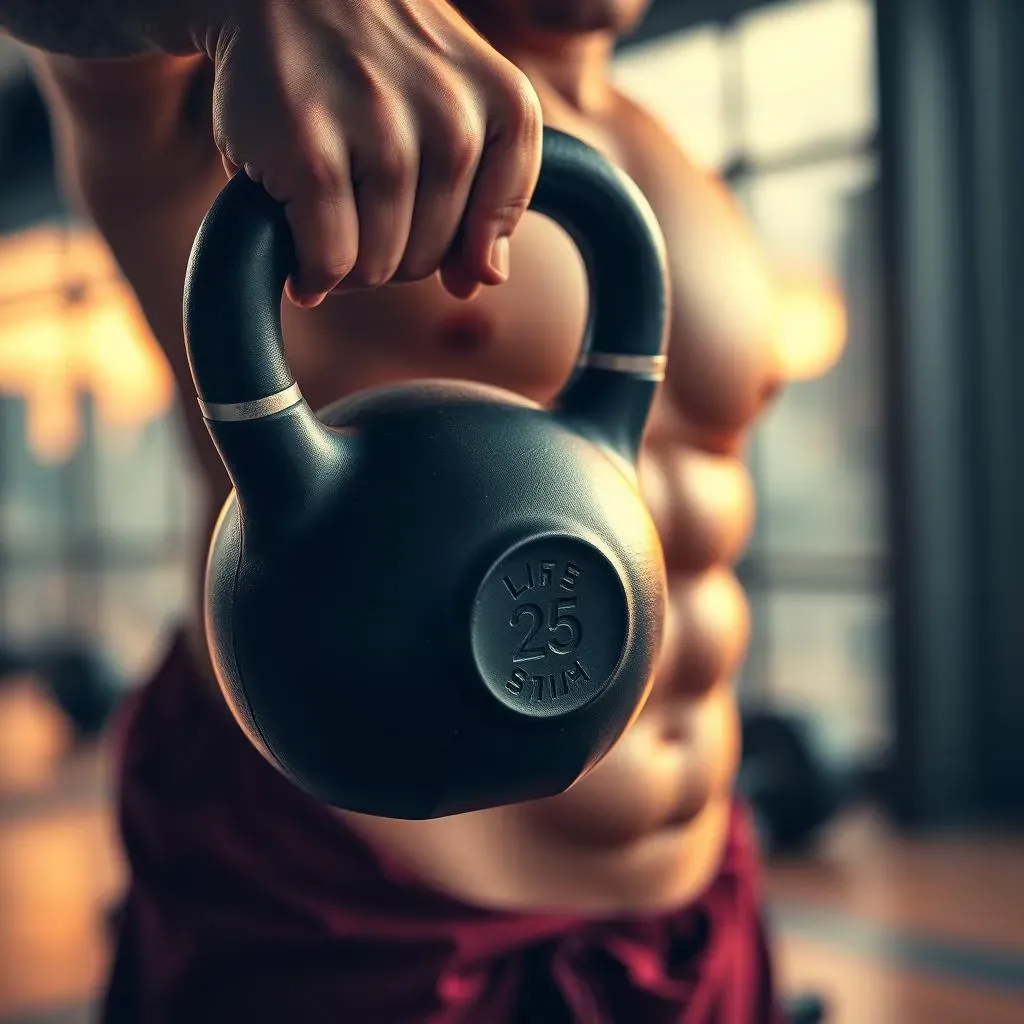Table of Contents
Ever feel like your upper back is a weak link? Maybe you're hunched over a desk all day, or perhaps you're just looking to add some serious strength to your physique. Well, you've come to the right place! We're diving headfirst into the world of kettlebell upper back training. Forget those boring, old-school back exercises; kettlebells are here to shake things up. This isn't just about building bigger muscles, it's about improving your posture, reducing injury risks, and feeling like a total badass. We'll start with a quick look at the muscles we're targeting, then explain why kettlebells are your new best friend for back workouts. Get ready to discover ten of the most effective exercises, along with a sample workout routine to get you started. Plus, we'll throw in some tips to make sure you're lifting safely and getting the most out of every rep. So, ditch the excuses and let’s get to work!
Understanding Your Upper Back Muscles

Understanding Your Upper Back Muscles
The Big Players
Okay, so when we talk about the upper back, we're not just talking about one big muscle. It’s a whole team working together! You've got the lats, those big muscles that run down the sides of your back, they help with pulling motions. Then there are the rhomboids, which sit between your shoulder blades, they're key for posture and pulling your shoulders back. The trapezius, or traps, are another big one, they stretch from your neck all the way down to the middle of your back. They help with all sorts of movements, like shrugging and stabilizing your shoulder blades. It's like a well-coordinated dance up there.
Don't forget the smaller guys. The teres major and minor muscles assist the lats and shoulder rotation. And the erector spinae, which run along your spine, they keep you upright. Even your biceps get in on the action during some back exercises. Knowing these players helps you understand why certain kettlebell moves are so effective. It is not just about looking good; it's about creating a balanced, functional upper body.
The Importance of Each Muscle
Each of these muscles plays a vital role, not just in lifting heavy things, but in our everyday lives. Strong lats help you pull yourself up, whether you're climbing a rock wall or just getting out of a chair. Rhomboids keep your shoulders from slouching, which is super important if you spend a lot of time sitting. Imagine a world without them! Your traps, well they're like the unsung heroes of your upper body, supporting everything you do.
The erector spinae are like the backbone of your back, holding you up and making sure you don’t collapse like a poorly built tower. All these muscles work together. It’s not about isolating one, it’s about building a strong, functional back that supports you in all your adventures. Understanding this will make your kettlebell training much more effective and fun.
Muscle Group | Primary Function | Why It Matters |
|---|---|---|
Latissimus Dorsi (Lats) | Pulling, Arm Adduction | Powerful pulling movements, back width |
Rhomboids | Shoulder Blade Retraction | Posture, shoulder stability |
Trapezius (Traps) | Shoulder Blade Movement | Neck and shoulder stability, upper back strength |
Teres Major & Minor | Shoulder Rotation, Assist Lats | Supporting shoulder joint, overall back strength |
Erector Spinae | Spinal Extension | Posture, spinal stability |
Why Kettlebells Are Great for Upper Back Training

Why Kettlebells Are Great for Upper Back Training
Dynamic Movements
Okay, so you know your back muscles, but why kettlebells? Well, unlike dumbbells or barbells, kettlebells are awesome for dynamic moves. Think about it: swings, cleans, snatches – these aren't just arm exercises, they engage your entire back, forcing those muscles to work together to stabilize and control the weight. It's not just about lifting; it's about moving with the weight, which is way more functional for real-life activities. You're not just building strength; you’re building a resilient back that can handle all sorts of challenges.
Kettlebells are like the fun, unpredictable cousin in the fitness family. They force your muscles to adapt in ways that traditional weights simply can’t. This leads to better overall strength and stability. Plus, the off-center weight of a kettlebell naturally engages your core, which is like a bonus workout for your abs!
Ergonomic Design
Another reason I love kettlebells is their design. The handle allows for a natural grip, which is much easier on your wrists and elbows compared to some other types of weights. And because the weight is off-set, it forces your back muscles to work harder to maintain control. This means you're not just isolating muscles; you are working them together in a more functional way.
The kettlebell's shape also lets you move through a wider range of motion, which is awesome for building flexibility and mobility in your upper back. You can perform swings, rows, and other movements that not only build strength but also improve your overall movement patterns. It’s like a two-for-one deal!
"The kettlebell is not just a weight; it's a tool for movement." - A wise fitness guru.
Versatility and Accessibility
Finally, kettlebells are just so versatile. You can use them for a ton of different exercises, targeting all those upper back muscles we talked about earlier. And, here's the kicker, they don't take up a ton of space, so you can easily work out at home. No need for a fancy gym!
Whether you're a beginner or a seasoned lifter, kettlebells can be adapted to suit your level. You can easily adjust the weight, the reps, and the type of exercises. This makes them a fantastic tool for anyone looking to build a strong and resilient upper back.
Advantage | Why It's Great |
|---|---|
Dynamic Movements | Engages back muscles in a functional way |
Ergonomic Design | Easier on wrists and elbows |
Versatility | Wide range of exercises, suitable for all levels |
Space-Saving | Ideal for home workouts |
Core Engagement | Bonus workout for abs |
Top 10 Kettlebell Exercises for a Stronger Upper Back

Top 10 Kettlebell Exercises for a Stronger Upper Back
Alright, let's get to the good stuff! You're probably itching to know which kettlebell exercises will actually give you that strong, sculpted upper back you've been dreaming of. I've got you covered. These aren't just random exercises; they're the tried-and-true moves that have helped me and countless others build incredible back strength. We're talking about a mix of pulling, hinging, and carrying exercises that will hit all those muscles we discussed earlier. Get ready to add these to your routine, and trust me, you'll feel the difference.
The Top 10
First up, we have the single-arm kettlebell row. This is your bread and butter for back strength, targeting those lats and rhomboids big time. Then there is the chest-supported row, which helps you focus on the back muscles without your lower back getting in the way. Deadlifts, are a must they work your entire posterior chain, including your back. And for some balance and core work, we have the single-leg Romanian deadlift. Don't forget the kettlebell pullover, which is fantastic for expanding your rib cage and working those lats.
Moving on, we've got the farmer's carry, a simple yet powerful exercise that strengthens your upper back and core. The alternating renegade row is another great one for core stability and back strength. And of course, we can't forget the classic kettlebell swing, which works your entire back. Kettlebell cleans are also a great move for building power and strength. Last but not least is the back extension, which really targets your lower back and erector spinae.
Exercise | Primary Muscles Worked | Why It's Effective |
|---|---|---|
Single-Arm Kettlebell Row | Lats, Rhomboids | Builds back strength, improves posture |
Chest-Supported Row | Lats, Rhomboids | Isolates back muscles, reduces lower back strain |
Kettlebell Deadlifts | Posterior Chain, Back | Full body strength, builds back power |
Single-Leg RDL | Hamstrings, Glutes, Lower Back | Improves balance, strengthens back |
Kettlebell Pullover | Lats, Serratus | Expands rib cage, strengthens lats |
Farmer's Carry | Upper Back, Core | Builds grip strength, improves posture |
Alternating Renegade Row | Back, Core | Builds core stability, back strength |
Kettlebell Swings | Posterior Chain, Back | Full body power, strengthens back |
Kettlebell Cleans | Back, Legs, Core | Builds power, improves coordination |
Back Extensions | Lower Back, Erector Spinae | Strengthens lower back, improves posture |
Now, I know that might seem like a lot, but don't worry, we're going to break down each exercise in more detail. I’ll also give you tips on how to perform them correctly, so you can get the most out of every rep. Remember, it's not just about doing the exercises; it's about doing them well. So, let’s get into the details and make sure your form is on point!
Sample Kettlebell Upper Back Workout Routine

Sample Kettlebell Upper Back Workout Routine
Getting Started: A 4-Week Plan
Okay, so you're ready to put all that knowledge into action? Awesome! This isn't just about throwing kettlebells around, it's about having a plan. This sample routine is designed to gradually build your strength over four weeks. We're going to start with the basics and slowly increase the intensity. Think of it like leveling up in a video game, but instead of pixelated characters, you're building a real-life, strong back. This routine focuses on hitting all those muscle groups we talked about, with a mix of strength and mobility exercises. Remember, consistency is key, so try to stick to the plan as closely as you can.
Each week, we'll be focusing on a few key exercises, and the goal is to either increase the weight, reps, or sets each week. This is what we call progressive overload, and it’s how you get stronger! Don't just go through the motions; focus on feeling the muscles working and maintaining good form. If you are new to this, start with a lighter weight and focus on the movement. Once you feel comfortable, you can start adding a little more challenge. It’s not a race, it’s a journey to a stronger you!
The Weekly Breakdown
Each week will have a slightly different focus, but the core exercises will remain the same. For week one, you'll be focusing on getting comfortable with the movements, using a lighter weight and focusing on form. Week two, we’ll increase the reps and sets. Week three is when you really start to feel the burn, adding more weight if you can. And week four, we’re going to push ourselves a little harder, testing your limits. Remember, it's all about listening to your body, so if you need to adjust, feel free to do so.
You can do this workout two to three times a week, with at least one day of rest in between. So, for example, you could do it on Monday, Wednesday, and Friday, and rest on Tuesday, Thursday, Saturday and Sunday. Before you start, make sure you warm up properly. A few minutes of light cardio and dynamic stretching is ideal. And after your workout, don't forget to cool down and stretch. This will help with recovery and prevent injury.
Week | Focus | Exercises |
|---|---|---|
Week 1 | Form and Technique | Kettlebell Deadlifts, Single-Arm Rows, Back Extensions |
Week 2 | Increased Reps | Kettlebell Cleans, Pullovers, Chest-Supported Rows |
Week 3 | Increased Weight | Kettlebell Deadlifts, Single-Arm Rows, Back Extensions |
Week 4 | Pushing Limits | Kettlebell Cleans, Pullovers, Chest-Supported Rows |
Tips for Safe and Effective Kettlebell Training

Tips for Safe and Effective Kettlebell Training
Start Slow and Master the Basics
Alright, so you're pumped to swing some kettlebells, but hold your horses for a sec. Before you go all out, it's super important to start slow and really nail the basics. I'm talking about getting your form down pat with lighter weights. Think of it like learning to play an instrument; you wouldn't start with a complex concerto, would you? You’d start with the basic chords. Same goes for kettlebells. Master the fundamental movements like the deadlift, the swing, and the row before you start adding weight or trying fancy variations. This will not only help you avoid injury, but also make your workouts way more effective in the long run.
Don't be tempted to lift too heavy too soon. It's not a race; it's about building a solid foundation. If you're unsure about your form, don't be afraid to ask a trainer or watch some videos. There are tons of great resources online that can help you nail those moves. Remember, it’s better to lift light with perfect form than heavy with bad form. Trust me, your back will thank you later!
Listen to Your Body and Progressive Overload
Now, this might seem obvious, but it's so important, I have to mention it. Listen to your body! If you’re feeling pain, don’t push through it. Pain is your body’s way of saying "Hey, something's not right here!" If something feels off, stop and adjust. It might mean your form isn't quite right, or that you need to take a break. Don’t let your ego get in the way of your progress. It's about being smart and consistent, not about pushing yourself to the point of injury. Recovery is just as important as the workout itself.
On the flip side, you need to challenge yourself. Once you’ve mastered the basics, you need to gradually increase the challenge. This could mean adding a little more weight, doing more reps, or increasing the number of sets. This is what we call progressive overload, and it’s how you get stronger. But, it’s not about adding weight every single workout. It's about making small, consistent changes over time. And, always, remember to maintain good form as you increase the challenge.
Tip | Why It Matters |
|---|---|
Start Slow | Master form, prevent injury |
Listen to Your Body | Avoid overtraining, prevent pain |
Progressive Overload | Ensure continuous progress, build strength |
Quality over Quantity | Focus on proper form over lifting heavy |
Warm Up | Prepare muscles, prevent injury |
Cool Down | Aid in recovery, reduce soreness |
Warm-up and Cool-down
I cannot stress this enough: never skip your warm-up! It's like getting your engine ready before a long drive. A good warm-up will get your blood flowing, loosen up your joints, and prepare your muscles for the workout ahead. Think of it as a way to tell your body, “Hey, we’re about to do some work, get ready!” I like to do some light cardio, like jogging in place, followed by some dynamic stretches, like arm circles and leg swings. This gets everything moving and reduces the risk of injury.
And, just as important as the warm-up is the cool-down. Don't just stop after your last rep and walk away. Take a few minutes to cool down, stretch, and let your body recover. This is when you’ll want to do some static stretches, holding each stretch for about 30 seconds. This will help to reduce muscle soreness and improve flexibility. Think of it like giving your body a nice, relaxing massage after a hard day’s work. It’s all about taking care of your body, so it can keep taking care of you!
"The key to safe and effective training is to listen to your body and respect its limits." - Some smart person, probably a doctor.
Wrapping Up Your Kettlebell Upper Back Journey
Alright, we've covered a lot, from understanding the muscles in your upper back to mastering ten killer kettlebell exercises. You now know that kettlebells aren't just for swings and squats; they're fantastic for building a strong, resilient back. Remember, consistency is key. Don't expect to become a back-building superhero overnight. Start with lighter weights, focus on proper form, and gradually increase the challenge. By incorporating these kettlebell exercises into your routine, you're not just building muscles; you're improving your posture, reducing your risk of injury, and enhancing your overall strength. So, grab that kettlebell, get to work, and prepare to feel the difference in your upper back. You've got this!